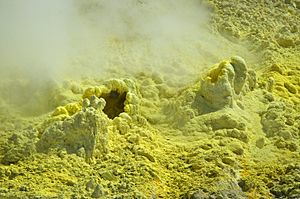Fumarole facts for kids

A fumarole is an opening in the Earth's crust, usually found near volcanoes. It's like a natural vent where steam and hot gases escape from deep underground. These gases can include things like carbon dioxide, sulfur dioxide, and hydrogen sulfide. The word "fumarole" comes from the Latin word fumus, which means "smoke."
Sometimes, fumaroles are called solfataras. This name comes from the Italian word solfo, meaning "sulfur." Solfataras are special types of fumaroles that release a lot of sulfurous gases.
Fumaroles can appear in many places. They might be along small cracks or long openings in the ground. You can find them in scattered groups or in large areas called fumarole fields. They also show up on the surfaces of lava flows and thick layers of volcanic ash. A fumarole field is a place with many thermal springs and gas vents. This happens when magma or hot rocks close to the surface release gases or mix with groundwater.
Contents
How Fumaroles Form and Change
Fumaroles can last for a long time, even hundreds of years, if they are above a steady source of heat deep in the Earth. However, some fumaroles might disappear quickly, within weeks or months. This happens if they form on new volcanic material that cools down fast.
A famous example is the Valley of Ten Thousand Smokes in Alaska. This valley was created during the 1912 eruption of Novarupta. After the eruption, thousands of fumaroles appeared in the cooling volcanic ash. But over time, most of them have stopped releasing gases as the ash cooled completely.
Where to Find Fumaroles
Fumaroles are found all over the world, especially in volcanic areas.
Yellowstone National Park
In the United States, there are about four thousand fumaroles within Yellowstone National Park. Yellowstone is famous for its many geysers and hot springs, and fumaroles are another sign of the park's active underground heat.
Mammoth Mountain
Fumaroles can be dangerous because of the gases they release. In April 2006, at Mammoth Mountain Ski Area in California, three ski-patrol workers died. They were overcome by toxic fumes that had gathered in a deep crack in the ground. This shows how important it is to be careful around these natural vents.
Dominica
Another place with many fumaroles is the Valley of Desolation. This valley is located in Morne Trois Pitons National Park in Dominica, a country in the Caribbean. It's a striking example of a landscape shaped by volcanic activity.
Images for kids
See also
 In Spanish: Fumarola para niños
In Spanish: Fumarola para niños




